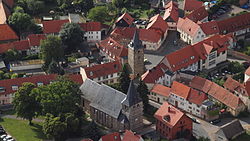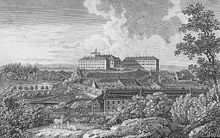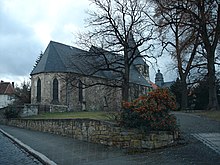The House of Ascania was a dynasty of German rulers. It is also known as the House of Anhalt, which refers to its longest-held possession, Anhalt.

The Duchy of Anhalt was a historical German duchy. The duchy was located between the Harz Mountains in the west and the River Elbe and beyond to the Fläming Heath in the east. The territory was once ruled by the House of Ascania, and is now part of the federal state of Saxony-Anhalt.

The history of Saxony-Anhalt began with Old Saxony, which was conquered by Charlemagne in 804 and transformed into the Duchy of Saxony within the Carolingian Empire. Saxony went on to become one of the so-called stem duchies of the German Kingdom and subsequently the Holy Roman Empire which formed out of the eastern partition of the Carolingian Empire. The duchy grew to become a powerful state within the empire, ruling over much of what is now northern Germany, but following conflicts with the emperor it was partitioned into numerous minor states, including the Principality of Anhalt, around the end of the 12th century and early 13th century. The territories of the Duchy of Saxony, the Principality of Anhalt, and their successors are now part of the modern German state of Saxony-Anhalt.

Gernrode is a historic town and former municipality in the Harz District, in Saxony-Anhalt, Germany. Since 1 January 2014, it has been part of Quedlinburg. It was the seat of the former Verwaltungsgemeinschaft of Gernrode/Harz.

Güntersberge is a village and a former town in Harz District, in Saxony-Anhalt, Germany. It has held the status of an officially recognized resort town since 2001. Güntersberge, together with the other municipalities of the former Verwaltungsgemeinschaft Unterharz, merged into the town of Harzgerode as of 1st of August 2009.

Harzgerode is a town in the district of Harz in Saxony-Anhalt, Germany.

Bernburg (Saale) is a town in Saxony-Anhalt, Germany, capital of the Salzlandkreis district. The former residence of the Anhalt-Bernburg princes is known for its Renaissance castle.

Alexisbad is a small spa town, part of Harzgerode in the district of Harz, Saxony-Anhalt, Germany.

Falkenstein/Harz is a town in the Harz district, in Saxony-Anhalt, Germany. It was created in 2002 by merging the town of Ermsleben with the former municipalities of Endorf, Meisdorf, Neuplatendorf, Pansfelde, Reinstedt und Wieserode. The new community was named after Falkenstein Castle.

Anhalt-Aschersleben was a short-lived principality of the Holy Roman Empire ruled by the House of Ascania with its residence at Aschersleben in present-day Saxony-Anhalt. It emerged as a subdivision from the Principality of Anhalt from 1252 to 1315.

The Principality of Anhalt was a State of the Holy Roman Empire, located in Central Germany, in what is today part of the federal state of Saxony-Anhalt.

Eduard Julius Ernst August Erdmann, Prince von Anhalt, also referred to by the courtesy title Prince Eduard, is the head of the House of Ascania, the family which ruled the Duchy of Anhalt until 1918.

Anhalt-Harzgerode was a small principality of the Holy Roman Empire, ruled by the House of Ascania with its residence at Harzgerode in present-day Saxony-Anhalt. It was created in 1635 following the partition of Anhalt-Bernburg with Frederick, a younger son of Prince Christian I becoming the reigning prince. The death of Frederick's son Prince William Louis in 1709 resulted in the extinction of the ruling family and Anhalt-Harzgerode was reunited with Anhalt-Bernburg.

Henry I, a member of the House of Ascania, was Count of Anhalt from 1212 and the first ruling Anhalt prince from 1218 until his death.

Victor Frederick of Anhalt-Bernburg, was a German prince of the House of Ascania. He was Reigning prince of the principality of Anhalt-Bernburg from 1721 to 1765.

Alexander Charles, Duke of Anhalt-Bernburg was a German prince of the House of Ascania. From 1834 until 1863 he was the last duke of the Duchy of Anhalt-Bernburg.

Anhalt Castle is a ruined medieval fortification near the town of Harzgerode in Saxony-Anhalt, Germany.

The Schwabengau was an early medieval shire (Gau) in the Eastphalia region of the medieval Duchy of Saxony. Ruled by the House of Ascania, it became the nucleus of the later Principality of Anhalt, today part of the German state of Saxony-Anhalt.
Esico of Ballenstedt is the progenitor of the House of Ascania,. Esico was the count of Ballenstedt, and his possessions became the nucleus of the later Principality of Anhalt.
Adalbert von Ballenstedtc. 970,, was Count of Ballenstedt, Vogt of the Nienburg Abbey, and the provost of Hagenrode. He is the earliest known ancestor of the House of Ascania.


























